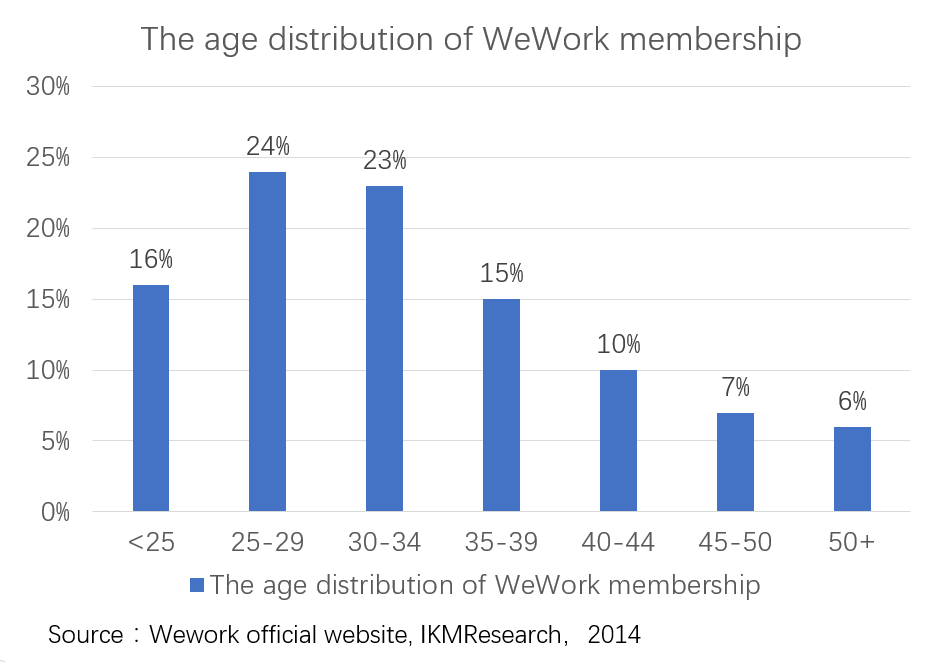
The year 2017 marked the largest growth in coworking, and produced all-time highs in number of spaces as well as number of members. In China, this phenomenon sweeps in many big cities, and now it is infiltrating into the second and third-tier cities.
The biggest coworking firm WeWork has witnessed these trends.
Recently, Ai Tiecheng, the manager of WeWork China, has explained the expansion blueprint of WeWork in China. The WeWork’s workstations are popular among the clients.
More than 180,000 members are registered in WeWork in the world, and 15,000 members are in China last year. The number in China has doubled in 2017. In the foreseeable future, this number will steeply climb.

What happened in the coworking popular trends?
In general, the coworking popular trends show these characteristics in China.
(1) The coworking space markets were hot in 2017 and the competitions are fierce.
The international coworking space are expanding their market in China. And the local coworking space are cooperated with each other to maintain the Chinese market share.

WeWork, which provides shared office space for users such as entrepreneurs, freelancers and large corporations, operates more than 212 properties in 22 markets including the United States(its biggest market), Canada, Germany and China.

Last year, it got $4.4billion funding from SoftBank. The funding aims to explore the Asia market, including China, Japan and India. After closing the deal and the fund rise, its valuation approximately hit $20 billion and become the world’s fifth most-valuable startups.

As for the local coworking space, Urwork, Chinese biggest coworking space operator, worked with another Shanghai’s biggest operator, FTtown, to set up a subsidiary to roll up into the fight. Not only the Chinese market but also overseas markets are on the race, when the Urwork opened 2nd Singapore branch in Suntec City last year.

It should be noticed that WeWork will expand its businesses to other cities in China this year, including Guangzhou、Shenzhen、Chengdu、Hangzhou、Suzhou、Nanjing、Xian and Wuhan. No doubt we can quickly see the fight extending to more and more cities in China this year.

(2) The coworking trend has infiltrated into the second and third-tier cities.
In the past, the coworking space take the first-tier cities as priority. Now they are turning to the cities like Chengdu and Hangzhou. At the same time, the talents also share the same flow direction. Hangzhou attracts most on the list of net talent inflowing rate.

The background in China that catalyzes the behavior.
(1) The clustered network population in China accounts over 55% of the total population.
In China, the network population has reached to 771.98 million people by the time of 2017, which accounts over 55% of the total population(1.390 billion)in the country. It’s quite unbelievable achievement in the world, especially that more and more the elder and children are getting used to the network life.

Using the mobile phone is the main access for Chinese to get into the Internet. According to the official, the mobile phone is adopted by 97.5% of network population. The huge population provide a tremendous market for the startups and the individual. Business and entertainment needs can be easily satisfied.

(2) The youth in China behaves different from their predecessors in the working demands.
The new generation born in the 80s and 90s are no more facing the hunger. They have the strong willing to go for the freedom and respects. When the traditional jobs are sucked and switch their feelings off, they will turn to the freelancer.
Over 70% Chinese freelancers are under 30, which quite acts contrary to the situation in U.S.. In U.S., the people aged more than 40 will prefer to start their own business. The Chinese freelancers are in a relative young age, and they will have a different demands on the coworking office, which contributed to more opening and social atmosphere in the coworking space.

According to LinkedIn, the Chinese’s freelancers are from art and social media industry.

The concept of employment changes and simulates the huge demands for co-working space. In the coworking space, the needs of freedom and social are both satisfied.
(3) The big company are facing the expensive office cost and the global mobility.
With the business globalization, the big company always face business trip and the temporary office problem. The projects may be last for several months in different cities. Frequent changing the office add the cost. However, the long rent of traditional office is costly and impractical for the high mobility.

The coworking spaces like WeWork exactly meet the appetite of this international company by providing them floating, cheap and private space. 30% of WeWork’s clients are these enterprises, which protected the stable incomes to WeWork.

How does WeWork appear to all the demands?
(1) A healthier and suitable place for the big company and the small startups.
WeWork emphases the secretary and public area for the users. The spirits are delivered to the design of the building structure and the arrangement of the space, making different branches sharing the same style to strength its brand effect.
(2) An attractive atmosphere for the youths.
The ages distribution of WeWork clients are mainly concentrated into the age under 35. The young man aged under 30 accounts for nearly 40% of the total clients. These type of people are more energic and gregarious, which results in the innovative community.

(3) A sustainable incomes to construct the incubation systems.
Up to now, WeWork has launched in 66 cities in the world, serving more than 400 entrepreneurs and 300 startups, successfully nursing Consmr, Truf, Fitocracy, Reddit and New York Tech Meetup.
Its sub-institution, WeWorklabs, is dedicated to the incubation of the early startups, offering the right things to meet their most urgent needs. WeWork has the appetite to build a sustainable structure to make the profits from the incubation by tying the startups and the co-working space with a strong community. What they do now is just to make this structure steadier and provide visible and invisible service approach to creativity.

The cooperation with the big company like Didi in China protects it from the unsteady loss in the incubation and this work feeds the system back, where Chinese local coworking and incubator operators should learn from.